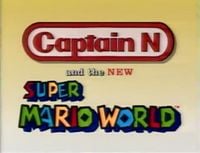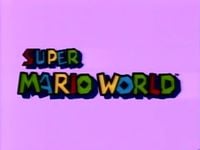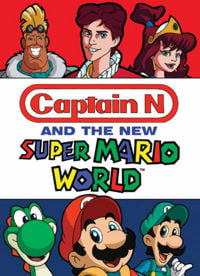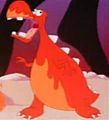Super Mario World (television series)
- This article is about the television series. For the SNES game, see Super Mario World.
Template:Cartoon Super Mario World is an animated television series that is loosely based on the game of the same name. The cartoon chronicles the adventures of Mario, Luigi and Princess Toadstool in Dinosaur Land. Yoshi and several new characters, such as Oogtar the caveboy, make an appearance as well. Super Mario World was the last of DIC's Super Mario cartoons and originally aired from September 14th, 1991 to December 7th, 1991.
Overview
Sometime after the events of The Adventures of Super Mario Bros. 3, having banished King Bowser Koopa, the Koopalings and their minions from the Mushroom Kingdom for good, Princess Toadstool, Mario and Luigi decide to take a vacation to the Dinosaur World. However, King Koopa and his minions manage to follow them there and kidnap the princess yet again. After adventuring and befriending Yoshi, Mario and Luigi managed to rescue Princess Toadstool from King Koopa's Neon Castle and subsequently decided to stay in Dinosaur Land's Dome City with the cave-people.
Several episodes of Super Mario World often had Mario, Luigi, Yoshi, Princess Toadstool and occasionally Oogtar, a show-exclusive character, trying to stop the schemes of King Koopa and the Koopalings, as well as other villains such as Wizenheimer or the DinoRiders. Toad, who appeared in The Super Mario Bros. Super Show and The Adventures of Super Mario Bros. 3, does not appear in the series (nor did he appear in the game it was based on), making it the only Mario cartoon where he does not appear. Mario, Luigi, Princess Toadstool, King Koopa and the Koopalings retain their designs from The Adventures of Super Mario Bros. 3, although the "L" on Luigi's cap is black instead of green in early episodes, Princess Toadstool has lighter skin and blue eyes instead of black eyes, and Cheatsy's hair is yellow/white instead of light blue. Also, Mario and Luigi's fire forms in the show are based on their fire from sprites from the game. Walker Boone, Tony Rosato, Tracey Moore and Harvey Atkin reprised their roles as Mario, Luigi, Princess Toadstool and King Koopa in the show.
Social issues

Some episodes of Super Mario World can also be seen as social commentary for controversial issues, such as street gangs ("Born to Ride"), addiction ("Rock TV"), bullying in school ("A Little Learning") and obesity ("King Scoopa Koopa").
The show also had several episodes, such as "The Wheel Thing" and "Party Line", dealing with the introduction and consequences of introducing new concepts and technologies to others without thinking ahead, in this case, the cave-people of Dome City.
Differences from the game
Super Mario World, though based on the video game of the same name, included several creative licenses. The cave people and Dome City are both introduced in the television series. Characters retained their color differences from The Super Mario Bros. Super Show! King Koopa was only once referred to as "Bowser" and the Koopalings retained their alternate names from The Adventures of Super Mario Bros. 3. Many locations and enemies were referred to by different names:
- Boos were referred to as "Ghosts".
- Banzai Bills were referred to as "Magnum Bills".
- Bowser's Castle was referred to as "Neon Castle" and "Coney Island Disco Palace".
- Chargin' Chucks were referred to as "Koopa Football Players".
- The Forest of Illusion was referred to as "the Enchanted Forest".
- Mechakoopas were referred to as "Mechkoopas" or "Robot Koopas".
- Magikoopas were referred to as "Koopa Wizards".
- Sumo Brother was referred to as "Fire Sumo."
- Wigglers were referred to as "Caterpillars".
- Monty Moles were referred to as "Gophers".
- Power Balloons were referred to as "Magic Balloons".
- Dry Bones were referred to as "Mummies".
- What appears to be either Spiny Cheep Cheeps or Porcupuffers were referred to as "Porcupinefish".
- Rexes and Dino Rhinos were referred to as "Dinosaurs".
Airing history
Super Mario World originally aired alongside Captain N: The Game Master on NBC, where it was referred to as Super Mario Bros. 4 in commercial bumpers. Super Mario World was also the only Mario cartoon to air in Australia on Network Ten and Cheez TV, though only on Mondays to Wednesdays on the latter. Oddly, in both the United Kingdom and Australia, the episode "King Scoopa Koopa" aired before "The Night Before Cave Christmas", due to a mishap involving the show's production order and the production order of Captain N: The Game Master.
Along with Captain N, Super Mario World was one of the last cartoons to air on NBC as that network began to gradually phase out cartoons on Saturdays. Both were canceled by the fall of 1992 and replaced with a Saturday version of The Today Show, along with their TNBC block, which included such shows as Saved by the Bell and California Dreams. In the mid-nineties, the Super Mario World episodes aired on USA Network, without the Captain N episodes. The adventures of Sonic the Hedgehog, another cartoon based on a video game franchise by DIC, and Street Fighter, based on the popular fighting game, were also aired on USA Network around the same time.
Due to the nature of its production, Super Mario World is actually one half of a series entitled Captain N and the New Super Mario World, which also consists of the third season of Captain N: The Game Master. Although the "New" suffix was used to promote the Super Mario World game when the show first aired, it is part of the series' proper title, and was never dropped. An episode of this half hour series consists of a Super Mario World cartoon and either a Captain N cartoon, or a second Super Mario World cartoon. Due to legal issues, the third season episodes of Captain N and the Super Mario World episodes are inseparable, and have to be released on DVD in the same set. This also explains why the first two seasons of Captain N: The Game Master were released in a "complete series" set; the third season is part of a separate show.
In the Middle East, Super Mario World aired on Spacetoon along with Earthworm Jim starting in 2005, but in 2007, both it and Earthworm Jim were replaced by The Adventures of Super Mario Bros. 3. Super Mario World also aired on the Middle East version of Nickeloedeon but is no longer on that channel's schedule. It was also still airing on Spacetoon as of January 1, 2011, along with Earthworm Jim, The Land Before Time, Make Way for Noddy, and The Super Mario Bros. Super Show! after Spacetoon English shut down.
Since 2009, the show sometimes airs on KidsCo in Australia and since 2010 it has aired on the same channel in Spain and Portugal. It has also aired on Boomerang in South Korea.[1]
Distribution
The Super Mario World episode "The Night Before Cave Christmas" was released sometime in 1996 for a VHS tape entitled "Super Mario Bros. Super Christmas Adventures"; along with "Koopa Klaus".
Currently, DVDs of every single Super Mario World episode are available in Australia; the episode "A Little Learning" was also available on a VHS tape for a time in the UK.
Due to complications involving the use of Yoshi, it was originally thought that DVD box sets of Super Mario World weren't going to be made. However, those issues were resolved, and Shout! Factory has released a box set containing the complete series, along with the third season of Captain N: The Game Master. The DVD was discontinued in 2012, along with The Adventures of Super Mario Bros. 3: The Complete Series and The Super Mario Bros. Super Show Volume 1 and 2, when Cookie Jar Entertainment merged with DHX Media.
As of 2014, the episodes along with the Captain N segments have been streamed on WildBrain's YouTube Channel "WildBrain - Cartoon Super Heroes".
Cast
- Walker Boone — Mario
- Tony Rosato — Luigi
- Tracey Moore — Princess Toadstool
- Andrew Sabiston — Yoshi
- Harvey Atkin — King Bowser Koopa
- Tara Strong — Hip, Hop
- John Stocker — Oogtar, Koopa Wizard, Monty Moles, Koopa Football Players, Wizenheimer
- Tabitha St. Germain — Kootie Pie Koopa
- James Rankin — Cheatsy Koopa
- Dan Hennessey — Bully Koopa, Green Dinosaur, Purple Dinosaur, Rockman
- Michael Stark — Kooky von Koopa
- Gordon Masten — Big Mouth Koopa
- Judy Marshak — (Additional Voices)
- Catherine Gallant — (Additional Voices)
- Stuart Stone — (Additional Voices)
Staff
- Main article: List of Super Mario World (television series) staff
As with the previous show, Super Mario World was produced and directed by John Grusd, with DiC president Andy Heyward acting as the executive producer and creative supervisor. Animation was done by the Chinese studio Pacific Rim Productions, Inc. rather than Sei Young Animation Co., Ltd., except for the opening which was done by Canvas. Inc. The series is coproduced by Reteitalia S.P.A. and Telecinco.
Episodes
| Air Date | Episodes |
|---|---|
Songs
- Main article: List of Super Mario World songs
Gallery
- For this subject's image gallery, see Gallery:Super Mario World (television series).
Quotes
Names in other languages
| Language | Name | Meaning |
|---|---|---|
| German | Super Mario World |
- |
| Hungarian | Super Mario Világa |
Super Mario's World |
| Portuguese | Super Mario Brothers |
- |
| Romanian | Lumea lui Super Mario |
Super Mario's world |
| Spanish (NOA) | El Mundo de Super Mario |
Literal translation. |
Trivia
- For the German dub, the intro sequence originally used the German Plumber Rap from The Super Mario Bros. Super Show!
- Although the Koopalings appeared in the series, there are no episodes where all the Koopalings are together.
- This is the first depiction of Yoshi with actual hands instead of paws.
- When the Federal Communications Commission enacted the Children's Television Act in October 1990, Princess Toadstool's personality was changed to reflect that of a responsible adult throughout this show, whereas in the predecessor, she was more of a coming-of-age stereotype, most notably in Reign Storm and Kootie Pie Rocks.










